Was Akira Toriyama Inspired by Formula 1 Racer Ayrton Senna?
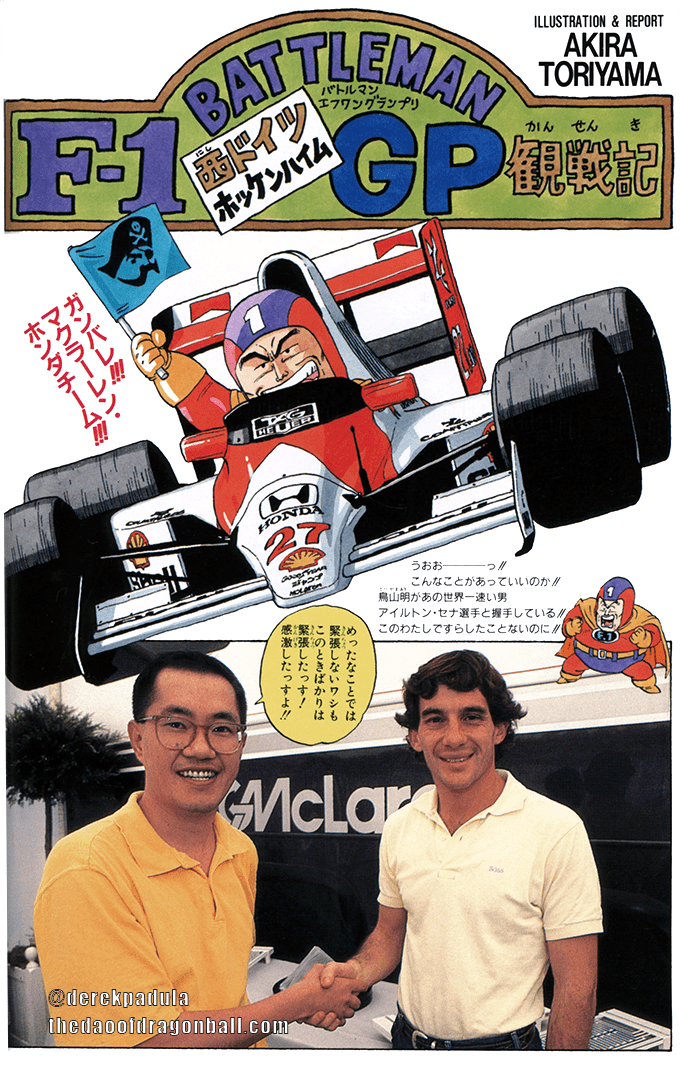
Did you know Akira Toriyama made a Formula 1 manga? Discover the truth behind this mysterious manga for the first time!
Akira Toriyama’s Formula 1 manga has been rediscovered and translated by me.
Few fans are aware of Toriyama’s manga, but you’ve probably seen this picture of Goku driving an F1 car:
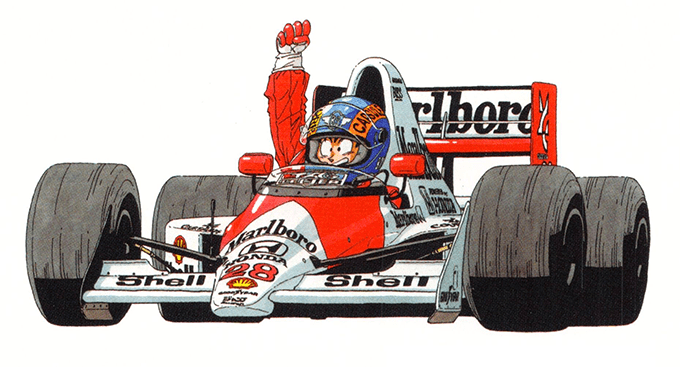
It turns out there’s a lot of history behind this image.
Why is Goku driving this car?
How is it connected to Toriyama’s Formula 1 manga?
What type of manga did Toriyama make, and where did he receive his inspiration?
In this article, you’ll learn the answers to these questions and many more.
Years of research and effort are coming your way at high speed.
Jump into your cockpit, put on your helmet, and hit the gas!
Principle Players
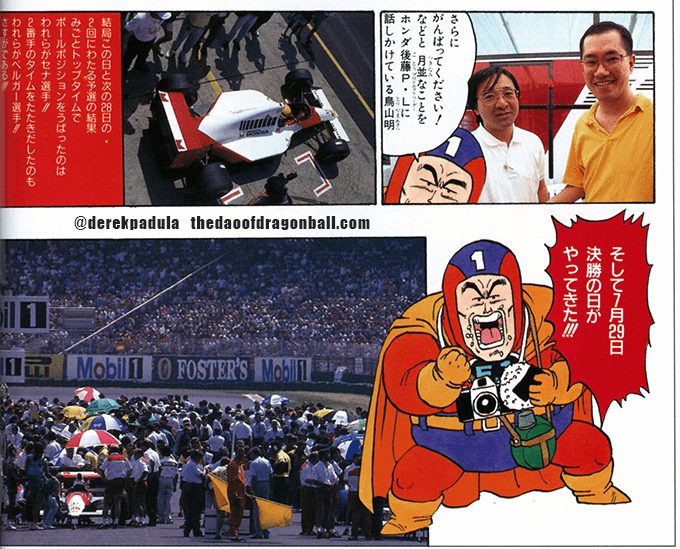
Akira Toriyama’s Formula 1 manga and Dragon Ball illustrations are the result of an international collaboration of efforts, with Toriyama at the center.
The principle players are Akira Toriyama, Honda Motor Company, McLaren Automotive, Shūeisha publishing, the Formula 1 racing organization, and one of its champion drivers: Ayrton Senna.
How did each of these entities get involved in creating a Formula 1 manga?
Our Formula 1 manga story begins, of course, with Formula 1 itself.

Formula 1 racing, also known as Formula One or F1, is the highest class of single-seat auto racing in the world.
Formula 1 has its name because every car involved in its races has to comply with the same ‘formula’ of rules.
F1 is the highest standard of rules, followed by F2 and F3.
A race in a Formula 1 tournament is called a Grand Prix (or GP), which is French for ‘Grand Prizes.’
The Grand Prix are held worldwide on tracks called circuits that are made specifically for these high-intensity races.
There are up to 21 races per year, from the Spring to Fall. Most Grand Prix are held in Europe.
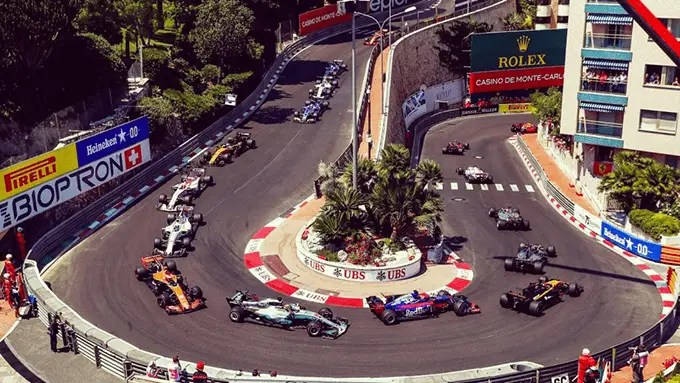
Monaco Grand Prix, in the streets of Monte Carlo
Formula 1 cars are the fastest race cars in the world, and each car can cost hundreds of millions of dollars to build and maintain.
Because of their expense, each driver seeks a team to construct a car for them. The team is then known as their ‘constructor.’
For this reason, there are only a few teams and a limited number of drivers, such as 4 to 10 teams and 20 drivers per race. It is an elite and high-level sport with athletes who push themselves and their engineering to the limit.
These teams of drivers and their financial sponsors then compete for the World Championship title of each year’s tournament.
This brings us to the Honda Motor Company.

Honda is a world-famous Japanese automotive company that is well-known in the West for producing affordable sedans, but in the world of racing they are known as a dominant provider of high-powered engines.
Honda participated in Formula 1 racing starting in 1964, as an engine manufacturer, constructor, and racing team. Their involvement with peak-level racing helped them develop more efficient engines and cars for the Japanese automotive industry.
As with all international sports, by proxy of a Japanese team’s involvement, many Japanese people were emotionally invested in Honda’s success and the outcome of their drivers and engines.
Fast forward to 1988 and Honda becomes responsible for manufacturing the engines of the McLaren Automotive team.

McLaren Automotive is one of the leading sports car manufacturers and racing teams in the world.
Headquartered in the United Kingdom, McLaren founded a Formula 1 racing team in 1985 and competed in international racing events.
They needed powerful engines and found them in Honda.
McLaren’s top driver was Ayrton Senna.
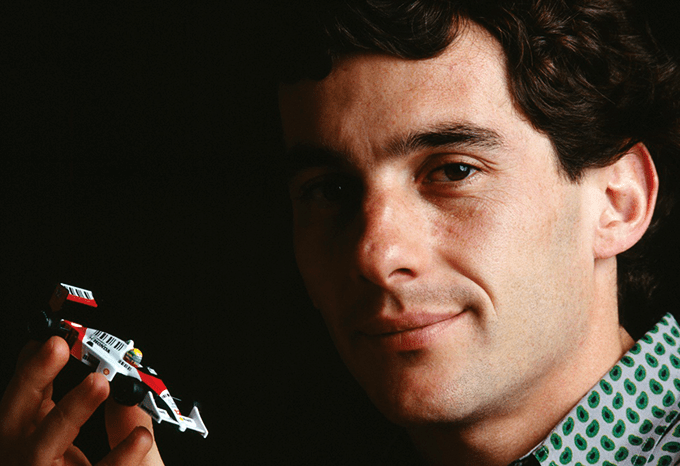
Ayrton Senna (March 21, 1960 – May 1, 1994) was a Brazilian race car driver and Formula 1 Champion in 1988, ’90, and ’91. He is regarded as one of the greatest Formula 1 drivers of all time. He is also a hero and sports legend to many in Brazil and abroad.
Senna would win the 1988 tournament driving the McLaren MP4 car. Engineered by McLaren and Honda, the MP4/1 was the world’s first Formula 1 car to use advanced carbon fiber materials.
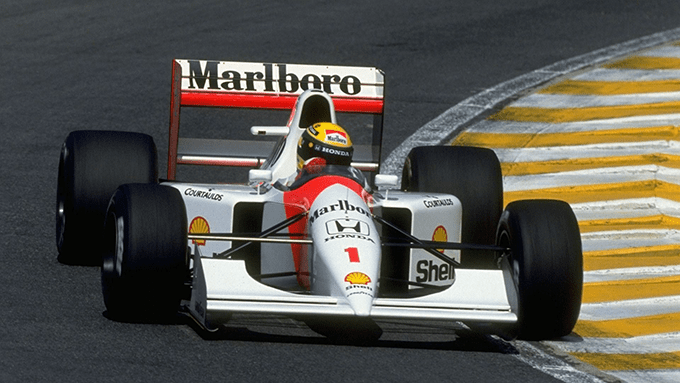
Each year the car would improve.
Its MP4/4 evolution had a tremendous 1,200 horsepower, which is 450 more than the F1 cars of today. This rocket-like car was tuned to a manual gearbox controlled by split-second decisions from the driver.
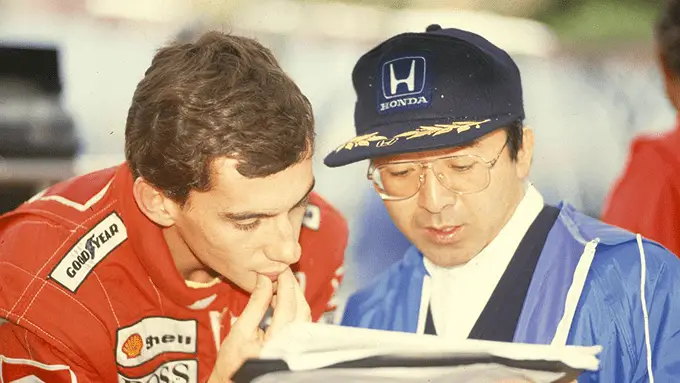
Ayrton Senna with Honda’s leader
Honda’s high-quality engineering allowed Senna and the McLaren team to dominate the Grand Prix from ’88 to ’91. They won 15 of 16 races in the ’88 season.
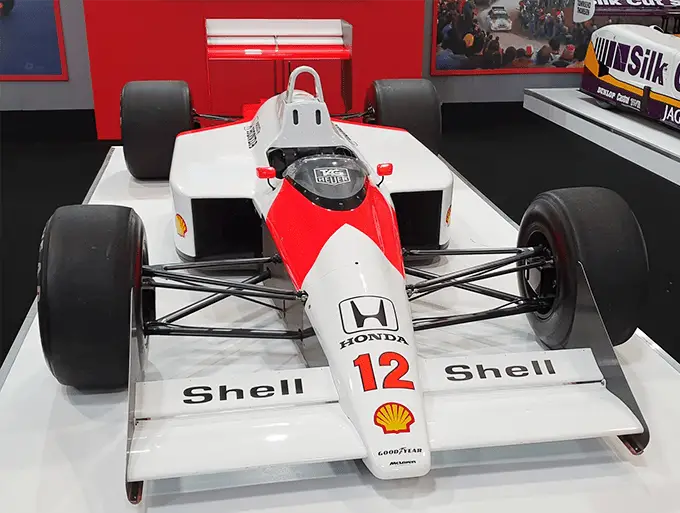
Ayrton Senna’s championship-winning 1988 McLaren M4 displayed at the 2020 Autosport International event, held at the National Exhibition Center in Birmingham, England. Picture credit: dbTruthUk
The McLaren – Honda team and drivers became legends in Japan because many of their championship victories occured at the Suzuka Circuit in Japan.
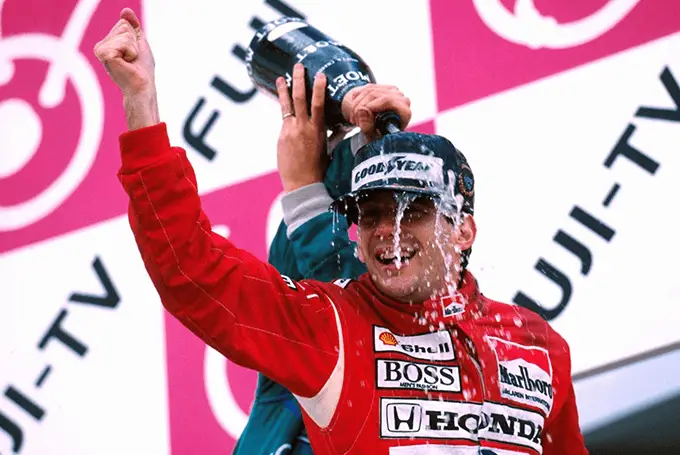
Ayrton Senna wins at Suzuka Circuit in Japan
In honor of Senna and his legacy with the company, in 2018 McLaren built a limited edition car in his name called the McLaren Senna.
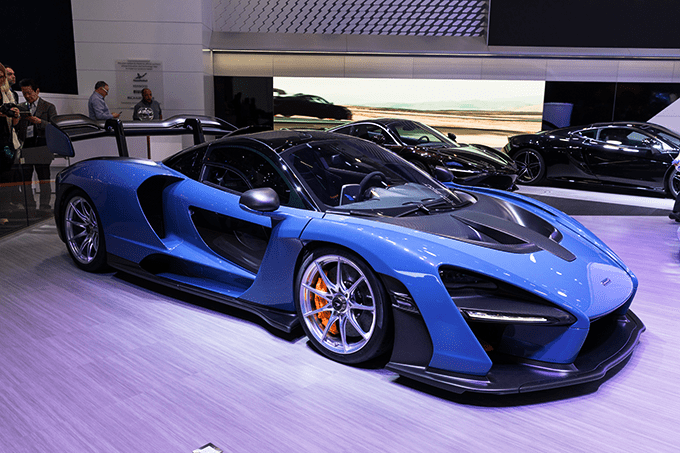
As a result of Honda’s interest in Formula 1, and the overall appeal of F1 racing, the Japanese had a surging interest in Formula 1.
Capitalizing on Japan’s newfound passion for F1, Shūeisha decided to sponsor McLaren’s Formula 1 racing team in 1989.

Shūeisha is one of the largest publishers in Japan.
They are the publishers of Weekly Shōnen Jump, the weekly manga publication that includes Dragon Ball and many other popular shōnen (少年, “young boys”) manga.

Weekly Shōnen Jump was the best-selling manga anthology in Japan during Dragon Ball’s run from 1984 to 1995, selling 5 to 9 million copies a week.
Dragon Ball was the primary force behind Weekly Shōnen Jump’s popularity.
So there were tens of millions of young minds who were enamored with Goku, his friends, and Toriyama’s work.
The exact reason for Shūeisha deciding to sponsor the McLaren team remains unknown.
But based on my research I would conjecture that it is because of the popularity in Japan at the time of Ayrton Senna and his teammates under the McLaren banner and Honda’s manufacturing leadership.
As part of the sponsorship deal, the Japanese logo for Weekly Shōnen Jump was placed on the nose of every McLaren race car for the ’89 season and onward.
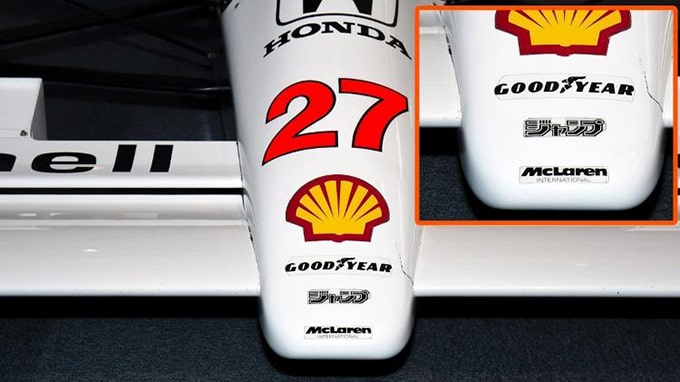
The logo is simplified as JANPU (ジャンプ, “JUMP”), which comes from the full name of “Shōnen Jump” (少年ジャンプ).
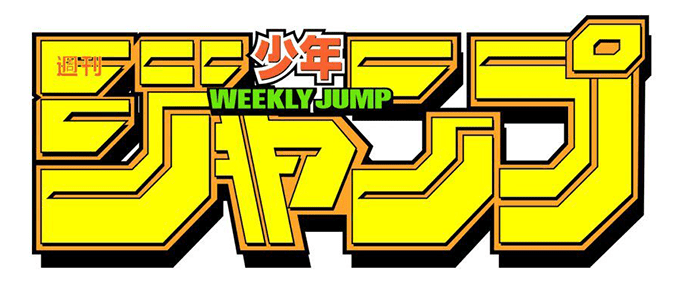
“JUMP” joined the other sponsor decals of Marlboro, Honda, Shell, Goodyear, and McLaren International. Not pictured on the nose is their additional sponsor, TAG Heuer, which can be found on the windshield in front of the cockpit.
Our last piece of the puzzle is Akira Toriyama himself.
Akira Toriyama Loves Cars
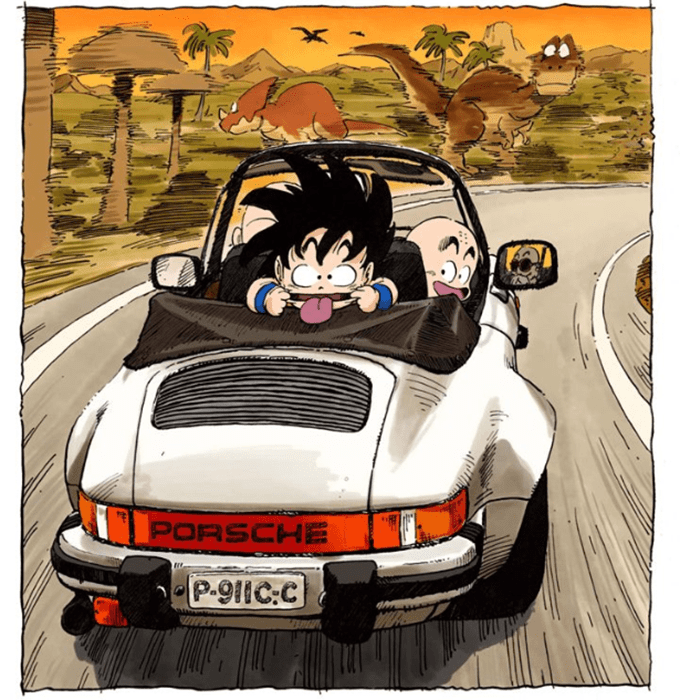
Akira Toriyama loves cars, motorcycles, planes, and other mechanical fabrications.
Toriyama’s father owned an automotive shop called Toriyama Motors, and the young Akira would spend countless hours in his father’s shop, around cars, motorcycles, various machines, and parts.
This fostered a lifelong love for automobiles of all kinds, from fast sports cars to dumpy-looking three-wheel oddities, imaginary science-fiction inspired meka as found on Japanese TV shows, and anything else with an engine.
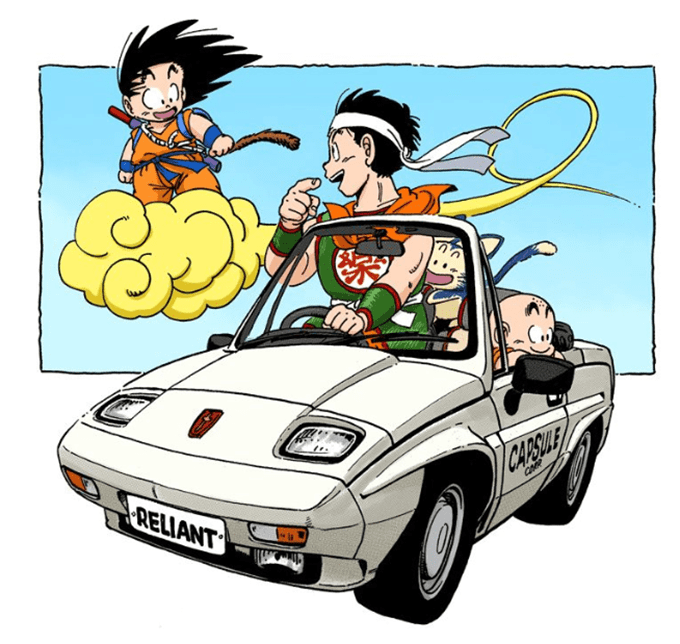
As a result of this lifelong interest in automobiles, many real-life cars can be seen in Dragon Ball.
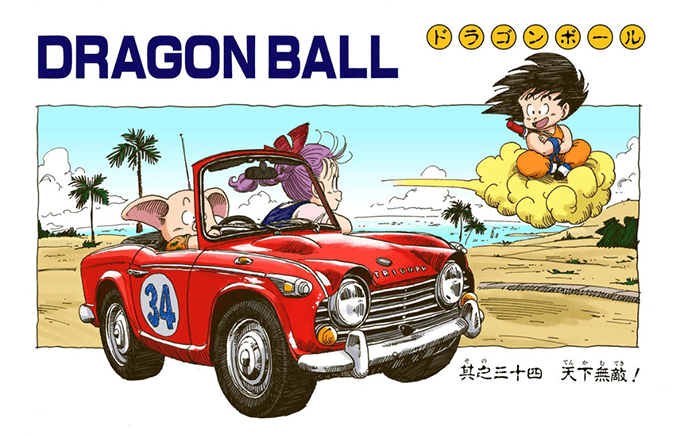
Thanks to Toriyama’s artistic talent, they look just like the original models they are based on. You can see this in the above 1984 Porsche 911 Carrera Cabriolet, 1984 Reliant Scimitar SS1, and 1965 Triumph TR4A.
Toriyama’s passion for vehicles can also be found in introduction messages for each week’s issue of Dragon Ball. For example, in Dragon Ball Chapter 23 he says:
“Whenever I have spare time, I go down to the motorbike mod shop. It’s so fascinating watching them work!”
To learn more about Toriyama’s love for vehicles, read my Dragon Ball Culture books. They reveal Toriyama’s life-story and detail each vehicle’s origin as they premiere in Dragon Ball, from start to finish.
Prior to the creation of the Formula 1 manga being discussed in this article, the exact amount of Toriyama’s interest in Formula 1 had been unknown.
But with the publication of this manga now available, it’s clear that when Shūeisha decided to sponsor the McLaren – Honda team, that Toriyama was happy to be along for the ride.
Shūeisha’s Sponsorship and F1 Manga
With Shūeisha’s sponsorship in full swing, the company pushed Formula 1 racing to Japanese children in their Weekly Shōnen Jump publications and on TV.
The above video is a commercial for Shūeisha’s McLaren sponsorship that shows the various Weekly Shōnen Jump covers that featured Formula 1 racing.
There’s a surprise at the end!
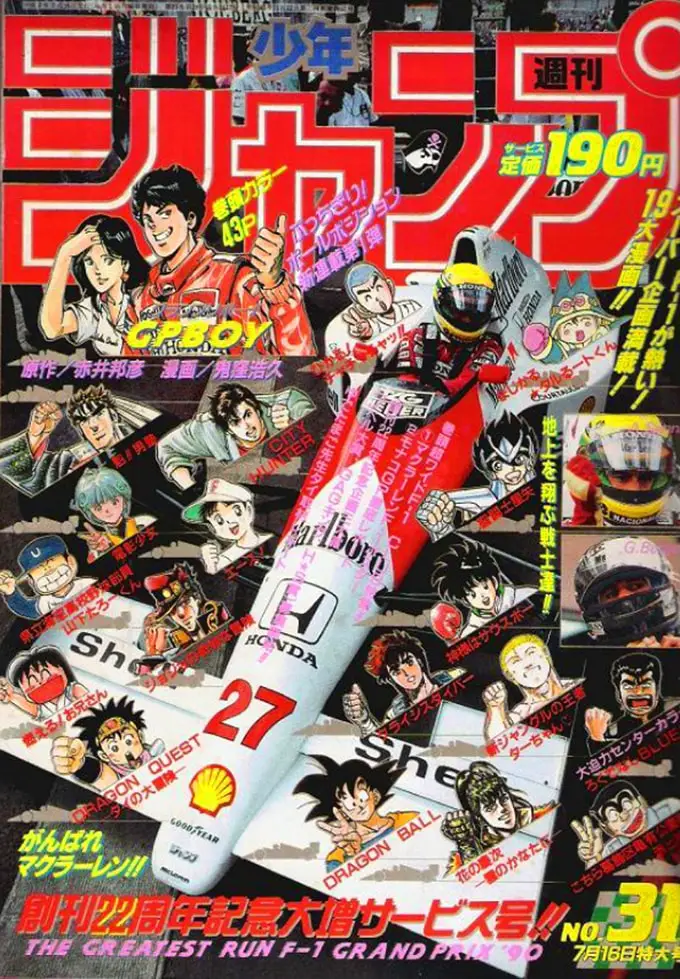
Weekly Shōnen Jump #31, 1990
In fact, Shūeisha had original stories about Formula 1 racing created by manga authors just to push it even harder.
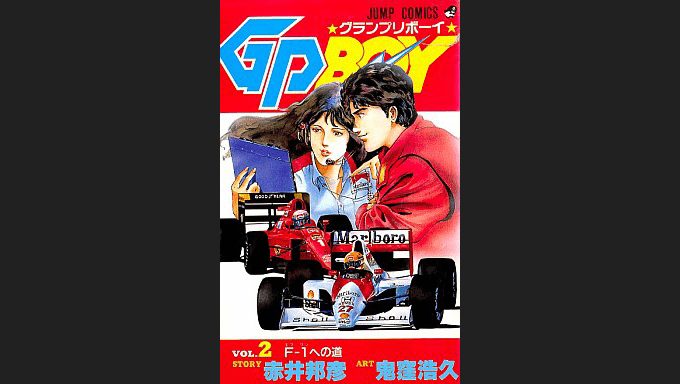
For example, GP Boy (GuranPuri Bōi, グランプリボーイ, in WSJ #31 and #47, 1990) is a two-volume manga created to commemorate Shūeisha’s sponsorship of McLaren.
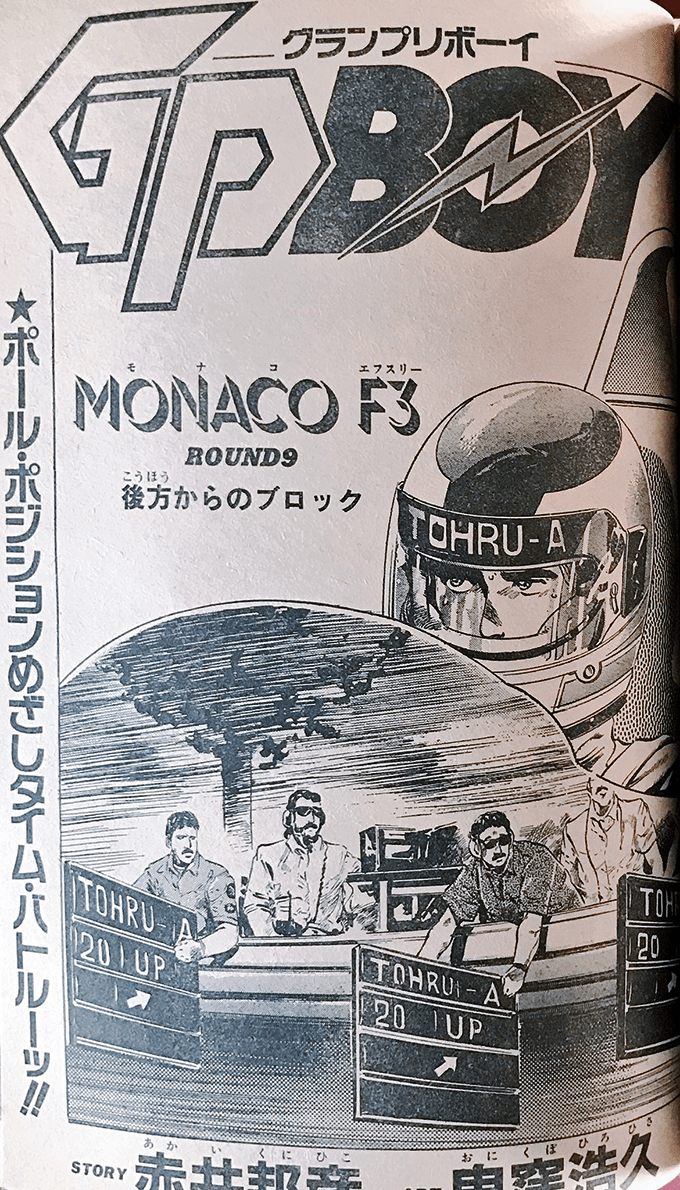
GP Boy tells the story of a young Japanese racer selected for McLaren’s F3 team. It was designed to appeal to Japanese boys to get them excited about racing. Ayrton Senna appears in the work.
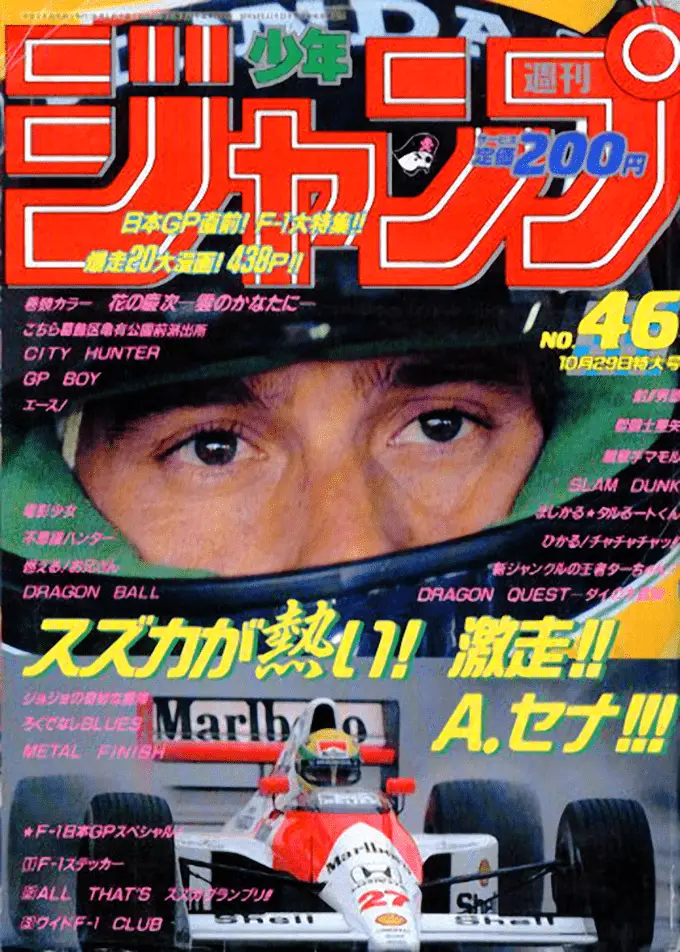
Weekly Shōnen Jump #46, 1990
Another is F no Senkō: Ayrton Senna no Chōsen (Fの閃光 -アイルトン・セナの挑戦, “The Flash Of F1: Ayrton Senna’s Challenge,” in WSJ #35 and #51, 1991). It is a two-volume manga that stars Ayrton Senna and focuses on his personal driving story and rivalries.
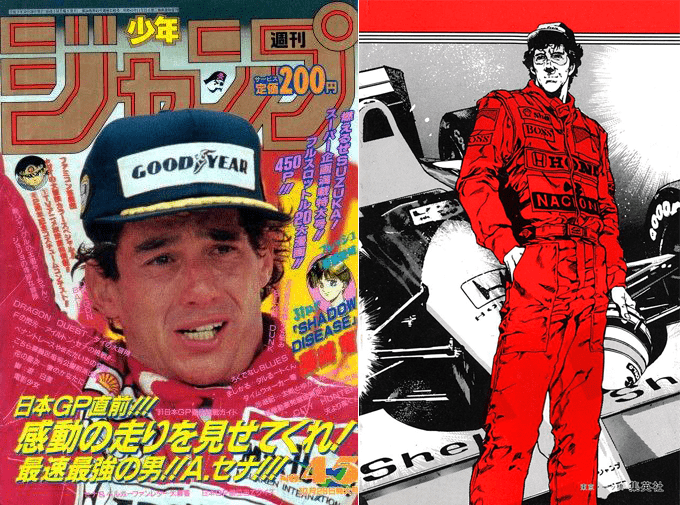
To that same end, Akira Toriyama drew Goku and his friends driving McLaren’s Formula 1 cars and celebrating championship wins as if they were Ayrton Senna.
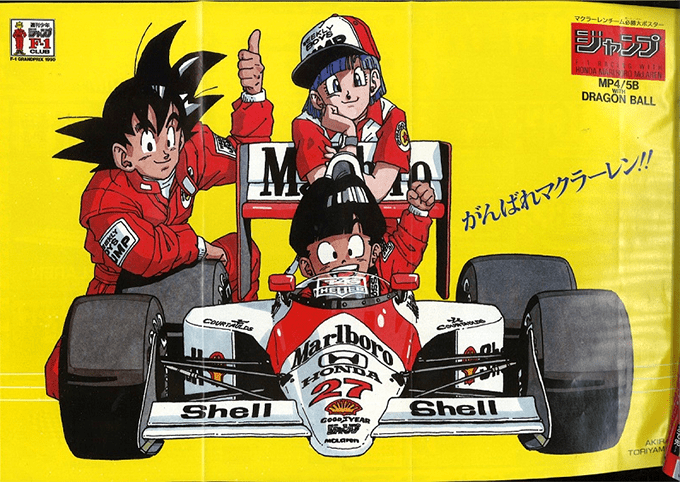
This is a poster that was included in a Weekly Shōnen Jump issue for June, 1990.
The English says, “F-1 racing with Honda Marlboro McLaren. MP4/5B with Dragon Ball.”
The Japanese says, “Good Luck, McLaren!!”
In the top left corner is an icon that says, “Weekly Shōnen Jump F-1 Club. F-1 GrandPrix 1990.”
Shūeisha wanted children to stare at this poster and associate F1 with Dragon Ball.
These cross-promotion marketing efforts aimed at children helped instill Senna’s fame, achievements, and the excitement of F1 in their minds.
Shūeisha aimed to cement the idea that Dragon Ball, McLaren, Honda, Formula 1, and Senna are each their best respective entities in the world, and they should go together in Japanese reader’s minds as the ‘highest-level.’
Senna’s Rise, Rival, and Success

Suzuka Circuit Map
Senna was a famous name in Formula 1 by 1989, but he became legendary in Japan when he won races at the Suzuka Circuit in Japan between 1988 and ’91.
Located 50 miles from Akira Toriyama’s hometown in Nagoya, the Suzuka Circuit was often the final race of the Grand Prix tournaments.
Many historic moments occurred between Senna, other drivers, and his own McLaren teammate and rival, Alain Prost.
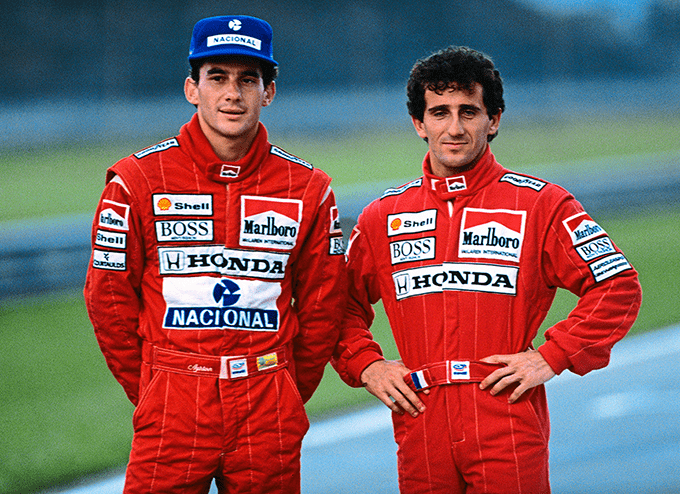
Odd as it sounds, even though they were on the same team, they always wanted to beat one another.
The Senna and Prost rivalry is the greatest in F1 history.

Ayrton Senna (L) and Alain Prost stare each other down after Senna hit Prost on the track at Suzuka Circuit 1989 and stopped both of their cars
Their rivalry continued for years.
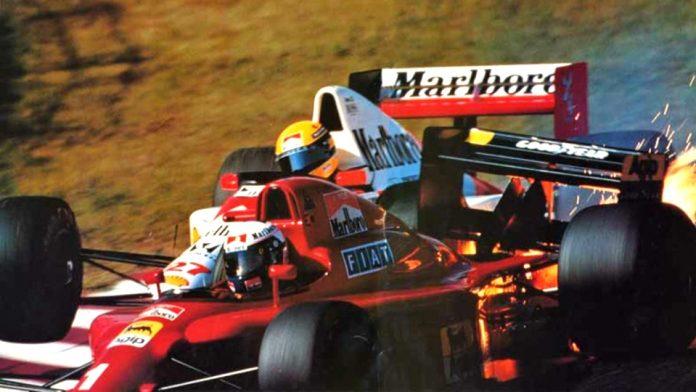
Ayrton Senna (rear) crashes into Alain Prost at Suzuka Circuit 1990
The peak of Senna’s racing career coincided with the peak of Dragon Ball in Japan.
The rise of Dragon Ball Z and Goku’s climactic battles with Vegeta and Freeza occurred as Senna competed against his opponents in the circuits.
Much like Senna battled his rival, Prost, Goku battled his rival, Vegeta.
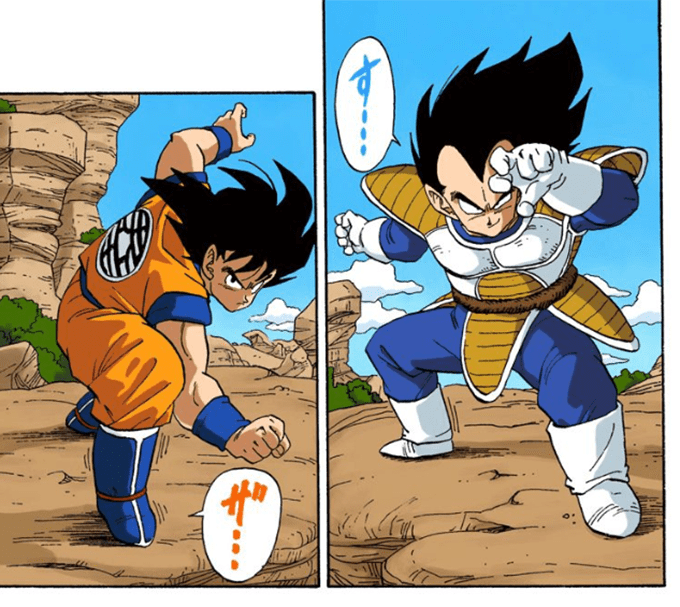
While many in F1 fandom agree that Prost was exceptional, most agree that Senna was superior. The more difficult the conditions, the better he performed.
Perhaps this famous and long-lasting rivalry is yet another reason why Shūeisha decided to associate Dragon Ball and Goku with F1 and Senna.
Toriyama’s Formula 1 Trip to Germany

All of these roads lead to Akira Toriyama traveling to Germany in 1990 to meet Ayrton Senna and the McLaren team at a Formula 1 race.
The details of how and why Toriyama would be sent as the envoy of Shūeisha is only known by those who were privy to the events at the time.
But if you know Toriyama’s mindset, then it sounds rather crazy to send him to a stadium full of thousands of people with cameras.
Toriyama is infamous for his concerns about being seen in public. He shows traits of agoraphobia (‘fear of crowds’). And he doesn’t want to be photographed.
Of all the people who work for and with Shūeisha, why choose Toriyama as their representative? And why would he agree to it?
I will conjecture that Shūeisha felt they wanted to promote their Formula 1 sponsorship among their readers with more focused and relevant content.
To do this they needed to show a relationship between the manga that Japanese readers enjoy the most and the Honda-backed team that they paid to promote their brand.
Therefore, the best person to send would be the most famous manga author in Japan: Akira Toriyama.
Likewise, the creator of the most famous manga in Japan: Dragon Ball.
It just so happens that Toriyama LOVES race cars!
And in this case his love of race cars overpowered his fear of crowds.
Formula 1 in Hockenheim, 1990
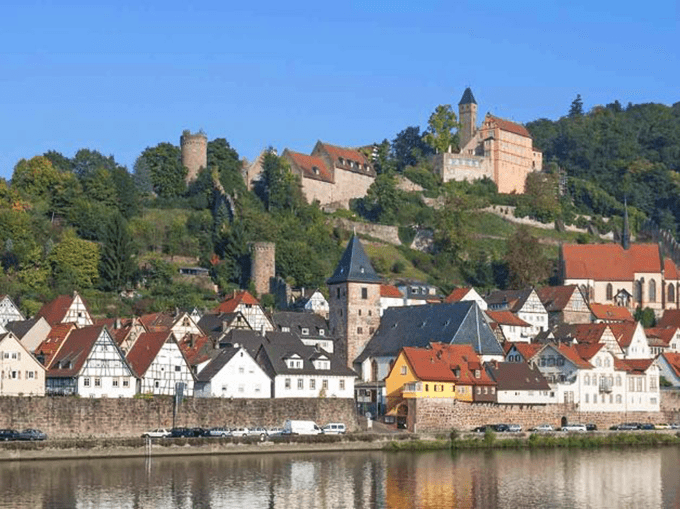
Toriyama traveled to Hockenheim, Germany to attend its July 29, 1990 Grand Prix. This was race 9 of 16 in the 1990 tournament.
Hockenheim is a small town in West Germany that is famous for its Formula 1 racing circuit called the Hockenheimring.
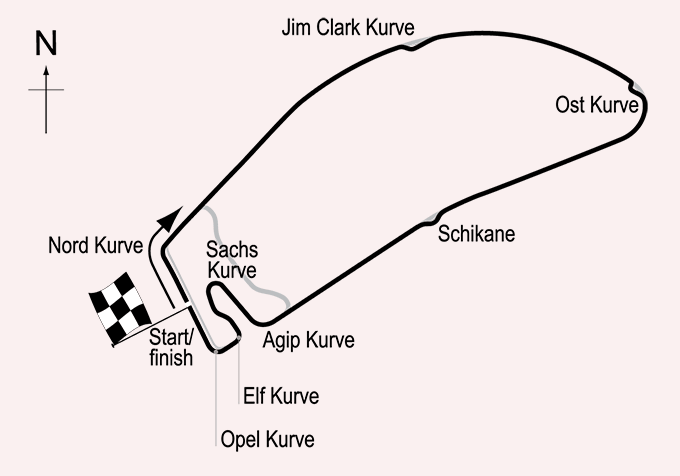
A Motor Sport Magazine review of Hockenheim’s 1984 race and its importance to the locals said the following:
“A stadium to the German populace is a bit like a golf course to the British, it is part of their nature and upbringing, and when that Stadium is alongside an Autobahn and only a few minutes from vast urban areas it is not surprising that the crowds pour in.”
One of those people who poured in for the 1990 race was Akira Toriyama.
Here is Toriyama enjoying the race:
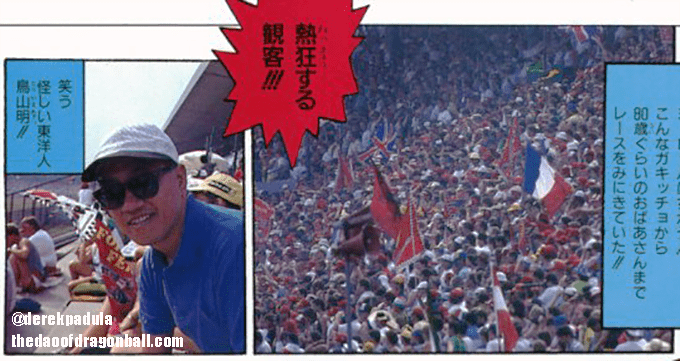
While there, he met Ayrton Senna, shook his hand, and experienced exclusive activities that were only made possible because of his status as an author and envoy of Shūeisha.
On that note, I’ll mention Toriyama’s own comments about his trip to Germany from his long-lost 2004 interview with BANZAI! Magazine at the Leipzig Book Fair. I translated this interview from the German myself after rediscovering it in 2019.
Toriyama is asked, “Is this your first time in Germany? How do you like it so far?”
Toriyama responds,
“Ten years ago, I visited Hockenheim for a Formula 1 race. At that time everyone was nice and helpful to me and I got a very good impression of Germany.”
Of course you may be thinking that 10 years prior to 2004 would have been 1994, while this race took place in 1990.
So did Toriyama make a mistake? Did he mean to say he visited 14 years ago, in 1990? Or did he visit Germany a second time in 1994 and just responded about the 1994 race because it was his most recent visit?
Given Toriyama’s infamous memory faults, it wouldn’t surprise me if he was thinking of his 1990 visit. But who knows. Maybe he visited twice but we only know of this single trip.
In any case, we now know why Toriyama traveled all the way to Germany for this race, and that he had a fun time.
However, Toriyama’s trip to Germany is merely the first half of this Formula 1 story.
Akira Toriyama’s F-1 Manga
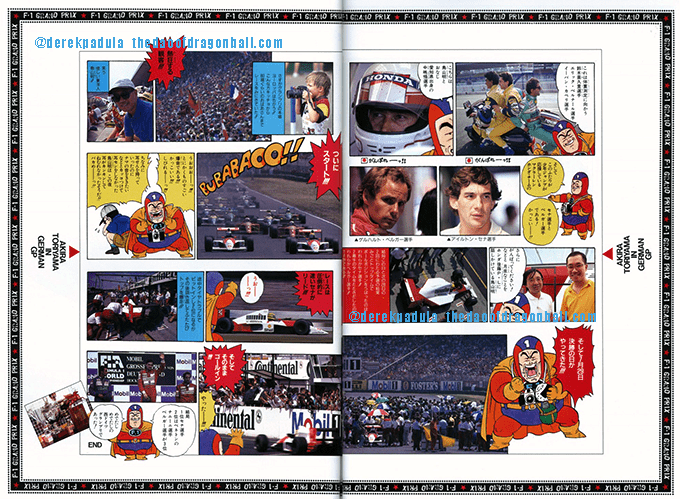
After returning to Japan, Toriyama created a manga that retells his experiences at Hockenheim in his own iconic Toriyama fashion.
The full title of Toriyama’s manga is Battleman F-1 West Germany Hockenheim GP Sports Report (Japanese: BATTLEMAN F-1 Nishi Doitsu Hokkenhaimu GP Kansenki, BATTLEMAN F1西ド イ ツ ホッケンハイムGP 観 戦 記, 1990).
We’ll call it Battleman for short.
Battleman is a four-page long journalistic report of Toriyama’s trip to Germany as if he were reporting on the race at Hockenheim as a professional sports journalist.
Battleman is the only known example of Toriyama creating a piece of journalism in his career. In English the manga is subtitled “Akira Toriyama in Germany GP.” So the story it tells is like Akira Toriyama’s personal Grand Prix.
Battleman is first published in Weekly Shōnen Jump #44, in 1990. It is then republished by Shūeisha as a standalone booklet (or ‘mook’) on January 10, 1991, called JUMP F-1 GRAND PRIX (ジャンプ F-1 グランプリ).
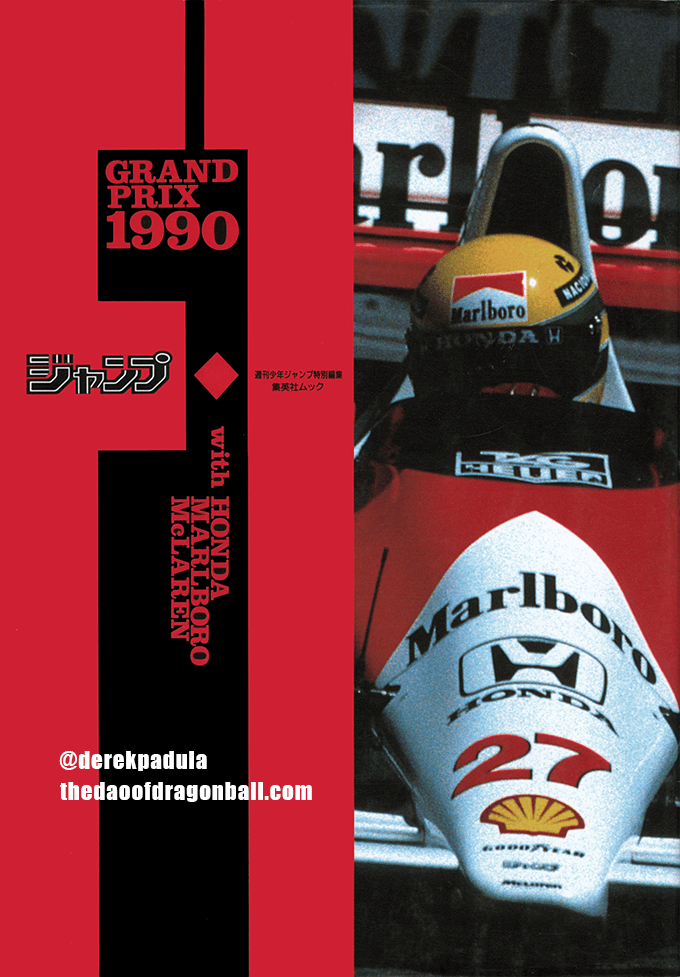
The print numbers of this one-off publication are unknown, but it is rare. It was only printed in Japan and has never been reprinted or licensed in other countries.
How did I get a copy?
I am friends with the founder of Kami-sama Explorer, the largest Dragon Ball fan site in Brazil. He owns a copy of the booklet and scanned the pages for me by request.
Despite Toriyama’s central role in the manga, Toriyama is not the one telling the story.
Battleman’s GP Report
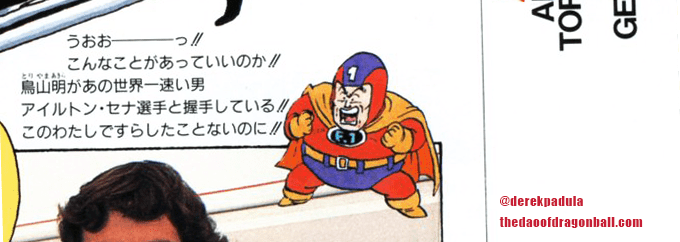
The story of Battleman is told through the perspective of the eponymous Battleman.
Battleman is an original creation of Toriyama’s that personifies a caped superhero with a fascination of Formula 1. He even has an “F-1” mark on his chest, similar to Superman’s iconic ‘S’-like symbol.
Battleman cannot fly, so he travels to Germany by plane to report on the event, just as Toriyama did.
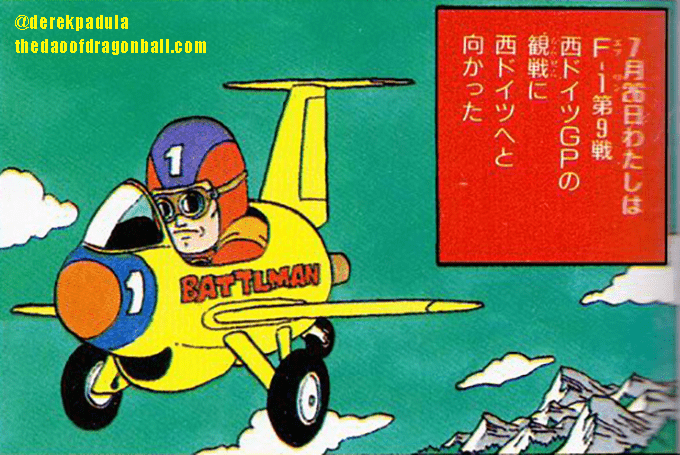
But he does have super speed. Just look at him run down the Autobahn!
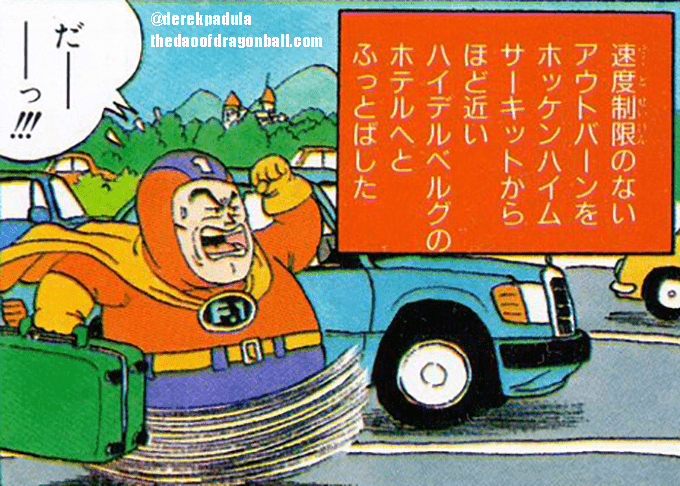
Over the course of the manga, Battleman gives a play-by-play of each moment of the race. This includes the days before the race, Toriyama’s meeting with famous racers, and the race itself.
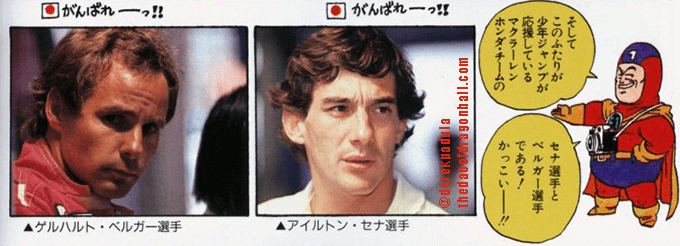
His entire report is done in a tongue-in-cheek manner, where Battleman mocks Toriyama in different ways.
The irony is that Toriyama is the one writing Battleman’s words, so Toriyama is making fun of himself in a self-deprecating manner.
Overall, it’s a great read and serves as a time-capsule of Toriyama’s writing and illustration style of the era.
Battleman = Real-life + Manga
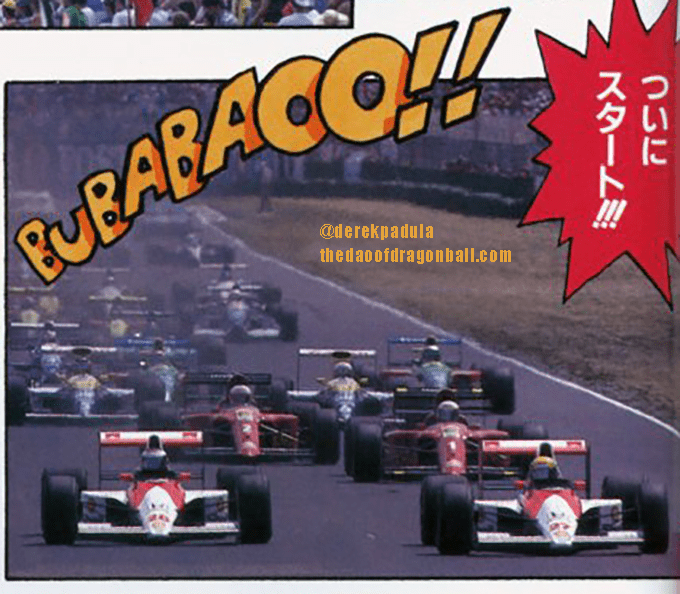
Battleman is a fusion of Toriyama’s manga illustrations and real-life photographs of the racers, stadium, audience, and Toriyama himself.
Toriyama then overlays speech bubbles, text, and sound effects on top of the illustrations.
For example, “BUBABAOO!!” is the sound of the Formula 1 race car engines starting.
Part of Toriyama’s signature style is to use English sound effects, as I discuss in my Dragon Ball Culture books, and that’s again what we see here.
I don’t know who took the photographs.
Many of them consist of Toriyama, so it’s fair to surmise that someone must have either accompanied Toriyama on the trip to Germany, he was supplied with a local photographer on the scene assigned to record each moment, or he lent his own camera to someone to take pictures of him.
As a result, we are treated to several historical photographs of Toriyama in this manga that have never been known among the fandom until now.
For example, here’s Toriyama standing on the track at Hockenheimring.
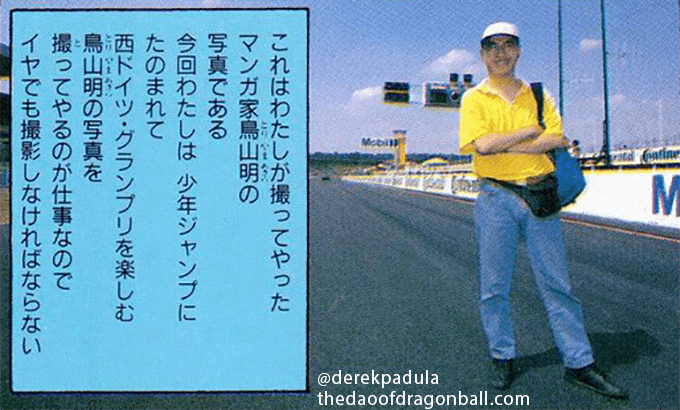
Here’s Toriyama inspecting a Formula 1 car with his artistic eye. No-doubt memorizing it for future illustrations.
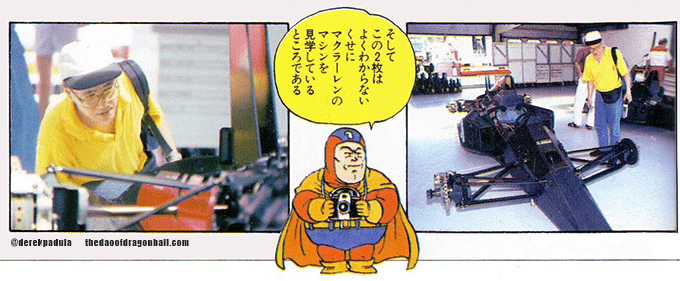
Given Toriyama’s fear of crowds, there are only a few photographs of Toriyama in existence past a certain point in the mid-1980s.
To have clear, colorful, and sharp photographs of Toriyama be recovered like this is a treasure.
Now that these pictures have been rediscovered and shared with the world on my site, Akira Toriyama fans have another reason to rejoice.
Akira Toriyama and Ayrton Senna
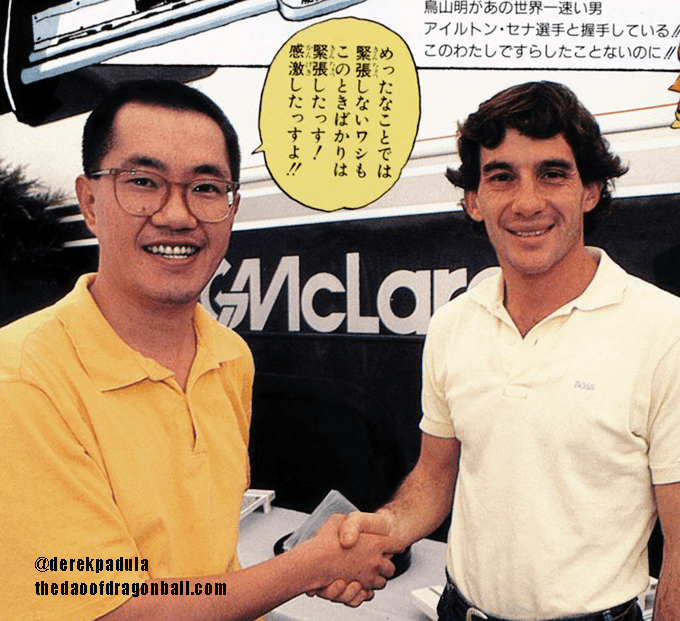
Throughout the Battleman manga Toriyama gives special attention to Ayrton Senna and the McLaren team.
This is no-doubt done because Shūeisha is McLaren’s sponsor, and Ayrton Senna is McLaren’s top driver.
But it’s also clear that Toriyama is a big fan of Senna’s.
Toriyama says on the title page of the manga where he shakes Ayrton’s hand and smiles:
“A cool guy like me rarely gets nervous, but now I’m super nervous! I’m really impressed!!”
Perhaps for Toriyama his trip to Hockenheim to meet Senna was more about pleasure than business.
Dragon Ball Formula 1
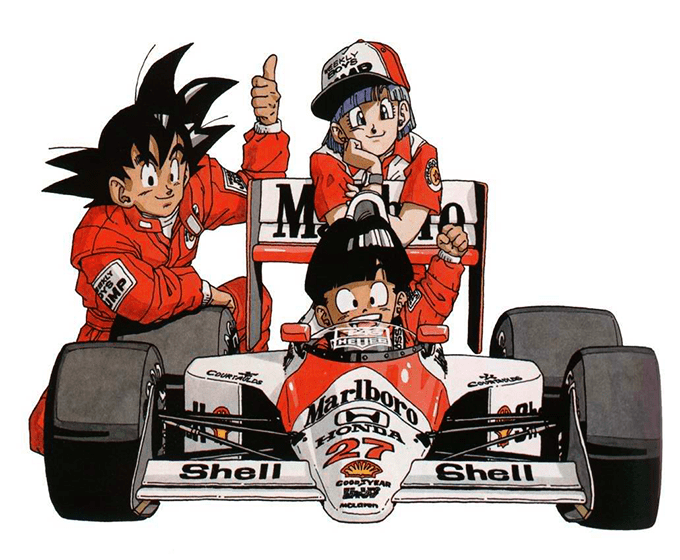
After Toriyama returned home and began work on Battleman, he was also tasked with creating a cross-promotion synergy between Dragon Ball and Formula 1.
To that end he drew additional Formula 1 illustrations alongside his weekly Dragon Ball publication.
The two ideas fused together to become what I have creatively coined ‘Dragon Ball Formula 1.’
With extensive research I managed to find images that Toriyama may have referenced in his artwork.

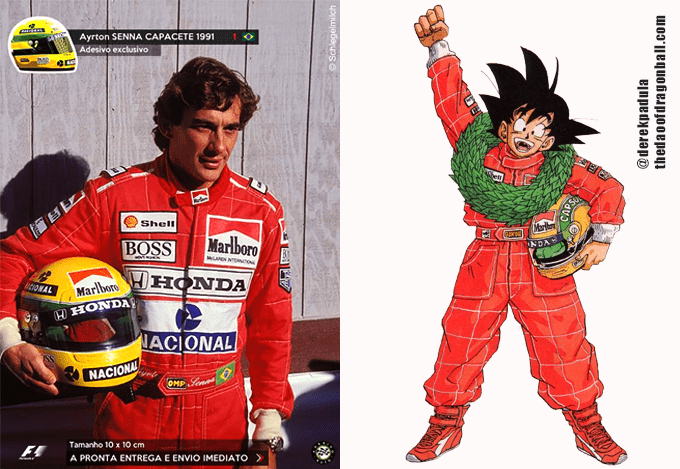
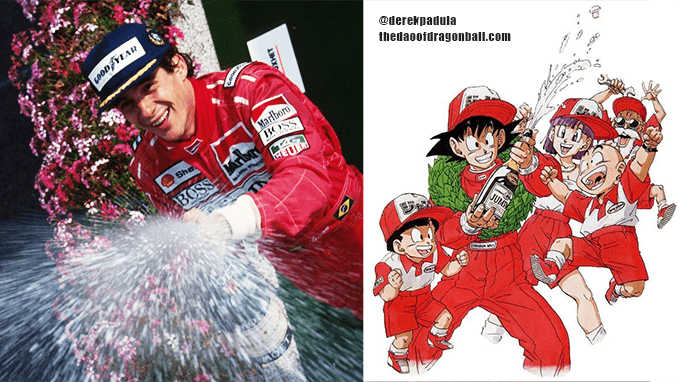
Here’s an example of them in official publications.
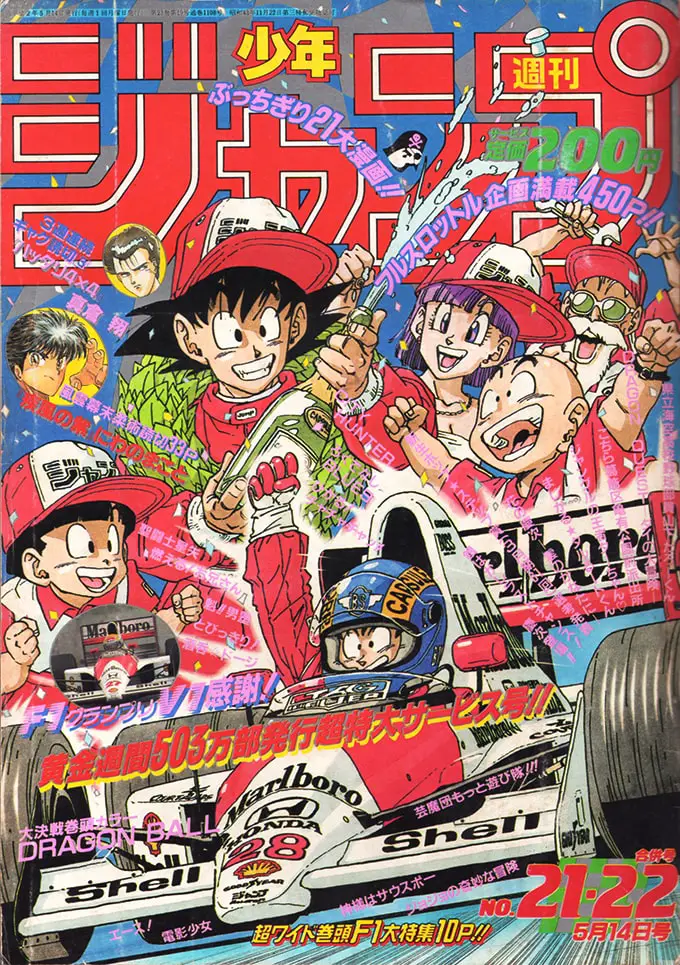
Weekly Shōnen Jump #21-22, for the week of May 14, 1990
Goku raises his fist in triumph as he wins the race, while his pit crew of Bulma, Krillin, Roshi, and Gohan celebrate.
Everything is a facsimile of Ayrton Senna’s victories in his 1990 McLaren MP4/5, as if Goku were Senna.
Given that Weekly Shōnen Jump was the biggest serialized popular publication in Japan during Dragon Ball’s original run, Toriyama’s love of Formula 1 and cross-promotion illustration of Shūeisha’s chosen racer created a synergistic effect.
Through Shūeisha’s sponsorship of the McLaren and Honda Team racing, and Toriyama’s illustrations and excitement for his favorite racers, Shūeisha forever popularized Formula 1 racing among a generation of Japanese youth.
End of Sponsorship
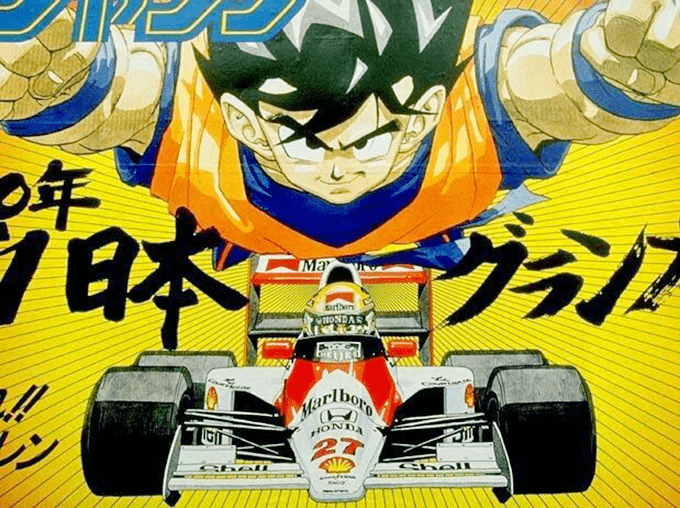
Despite their success, Honda decided to pull out of Formula 1 racing in 1992.
With this came the end of Shūeisha’s sponsorship of McLaren, and the end of Goku and the gang’s involvement in Formula 1.
Thus ended the relationship between Akira Toriyama, Dragon Ball, Shūeisha, Honda, McLaren, Senna, and Formula 1 racing in official publications.
But even so, the marketing effort succeeded in establishing a solid base of diehard Japanese fans, and they continued to watch F1 with attentiveness.
Likewise, the love of F1 continues in the hearts of racing fans in Brazil and elsewhere.
And thanks to Toriyama’s amazing illustrations of Goku driving an F1 car, so too does it live on in the hearts of Dragon Ball fans.
Finally, we can understand the history behind those classic images of Goku driving in F1.
However, as fate would have it, Akira Toriyama’s brief meeting with Ayrton Senna would be his last.
Ayrton Senna’s Death
Ayrton Senna died on May 1, 1994 at the San Marino Grand Prix in Imola, Italy.
Senna’s car’s steering column and tires malfunctioned, he crashed into a concrete barrier at 300 kilometers per hour (186 mph), and he suffered a fatal brain injury.
Senna was announced by the medics to be brain dead on the spot, and he was taken to the hospital by helicopter, where his heart stopped a few hours later.
The exact details of his death are still discussed and debated today. More videos and analysis are available.
Senna’s sudden death sent shockwaves throughout the racing community and led to many discussions on racing safety, of which Senna was a proponent.
In fact, the day before Senna’s death at San Marino, driver Roland Ratzenberger died during the qualifying race.
In response, Senna became angry and then later collapsed in tears.
The next morning, in an emotional fervor, Senna campaigned to reestablish the Grand Prix Drivers’ Association union to focus on driver safety and rights. And as a tribute to Ratzenberger, Senna carried an Austrian flag in his cockpit. He intended to wave the Austrian flag as he crossed the finish line.
Instead, Senna fell victim to a similar fate.
He was killed by the very thing he fought against.
As a racer, he knew this could happen at any moment.
But that was no consolation for those he left behind.
Mourning Senna
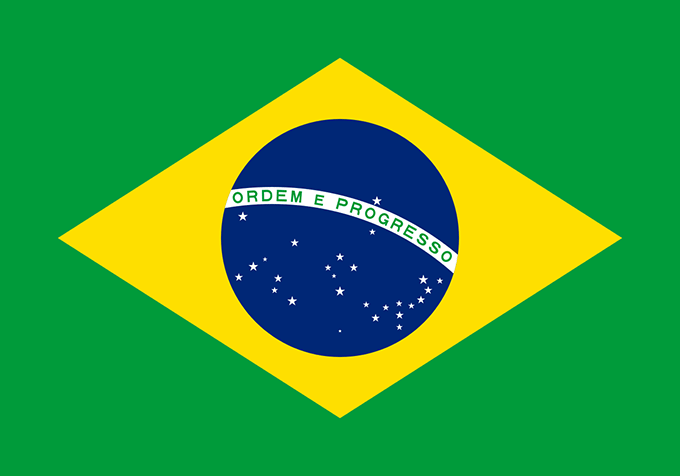
In Brazil, the government announced three days of mourning, with Brazil’s flags flung at half-mast.
On May 5, the government gave Senna a state funeral as a national hero, with a 12-gun salute and a flyover by the Brazilian Air Force. It was televised live across the country and 3 million people filled the streets of Senna’s hometown of São Paulo.
At Honda headquarters in Japan, Senna received so many floral tributes that they overwhelmed the lobby floor. This was still the case even though Senna was driving under the Williams Renault team in 1994, rather than Honda at the time of his death. Wikipedia says, “Senna had a special relationship with company founder Sōichirō Honda and was revered in Japan, where he received a near mythic status.”
As a silver lining, Senna’s death led to major safety reforms in the sport. The Grand Prix Driver’s Association was reestablished at the next F1 race in Monaco, and at the end of the season, adjustments were made to the cars to improve driver safety.
But Senna was gone.
Senna, Brazilians, and Goku
“Senna was like a god. We loved him. Not only me, but all Brazilians,” says a Brazilian citizen in this 1994 news report by EuroSport about Senna’s death.
I spoke with Kami-sama, the Brazilian Dragon Ball fan, about Senna’s death. I wanted to learn more about his experiences in Brazil at the time it happened.
Kami-sama said:
“Senna was our Brazilian Goku!! Senna was Brazil’s greatest hero. F1 doesn’t make any sense to us without Senna.”
He said, “I was in love with cars and Formula 1. When Senna died, I was about 14 years old. I haven’t watched F1 since his death and I never play F1 video games either. And I lost my interest in cars. I decided not to get my driver’s license in order to make a point about this.”
To this day, Kami-sama hates driving and will only take taxis or use ride-sharing apps.
He’s not alone. Fans on YouTube are still discussing Senna’s death, and one user echoed a similar statement:
“I was 16, saw it all… He was my hero… Cried like a baby all day… I never saw Formula 1 since 1994.”
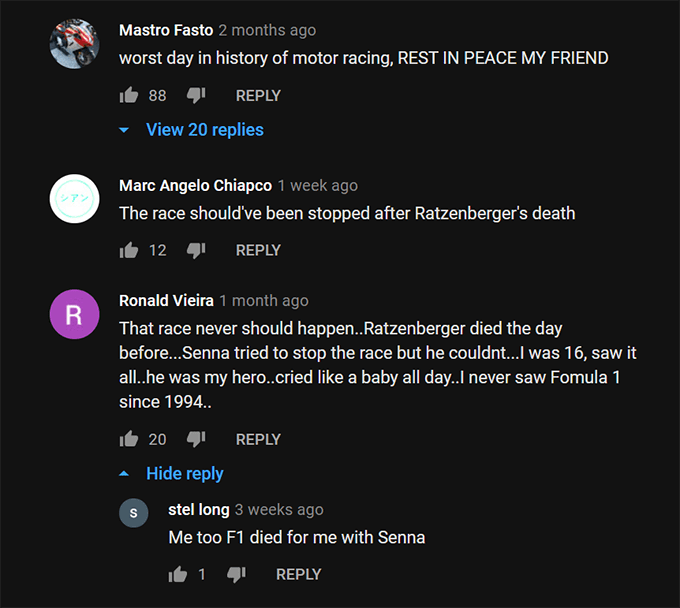
Senna’s death had a profound effect on Brazilians and on F1 fans across the world.
Senna was the hero to many, just like Goku is the hero to many.
But why did they love him so much? Was it just because of his racing feats?
Kami-sama said, “At that time, Senna represented a feeling that our country could overcome anything, a sense of ‘Never give up.’ Senna was meticulous, a perfectionist, always involved with every detail, and hated to lose. The Brazilians at that time had low self-esteem compared to others on the global stage. Senna showed up in an elitist sport, won championships, and proved that anything was possible.”
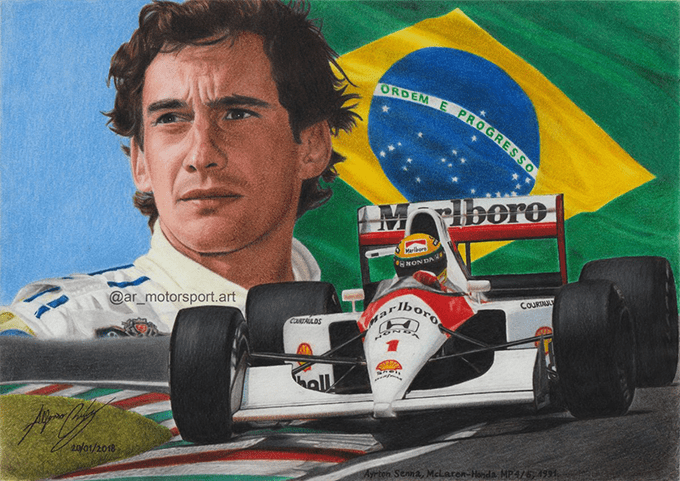
To the Brazilians, Senna was a real-life Goku.
Goku is like Senna in that he never gives up, is dedicated to his training, and seeks to conquer himself at every level. He’s also a low-class Saiyan who proved himself superior to the so-called elites.
Kami-sama says, “Maybe that’s why Senna was idolized in Japan too. And even more because Senna’s team invested in Honda engines.”
He felt that Senna may have inspired Toriyama in the creation of Goku’s personality, perseverance, and commitment to excellence.
Consider that the shift in Goku’s personality, from an innocent child with a pure heart to a battle-focused warrior obsessed with reaching the next highest level, coincides with Senna’s rise in stardom in the late ’80s and early ’90s, and the zenith of his abilities.
Senna is quoted: “Every time I push, I find something more, again and again. But there is a contradiction. The same moment that you become the fastest, you are enormously fragile. Because in a split-second, it can be gone. All of it. These two extremes contribute to knowing yourself, deeper and deeper.”
Senna’s philosophy is similar to Goku’s worldview, where he finds his greatest joy when approaching his own mortality and limits.
Then again, perhaps these similarities are a mere coincidence?
Kami-sama adds, “I don’t believe in coincidence.”
The official Formula 1 site says, “No one tried harder or pushed himself further, nor did anyone shed so much light on the extremes to which only the greatest drivers go.”
In this 25-year anniversary tribute of Senna’s passing by Top Gear, countless world champion drivers agree:
“Ayrton Senna was #1.”
Even though Senna’s body is no longer with us, his spirit lives on.
Toriyama’s Feelings on Senna
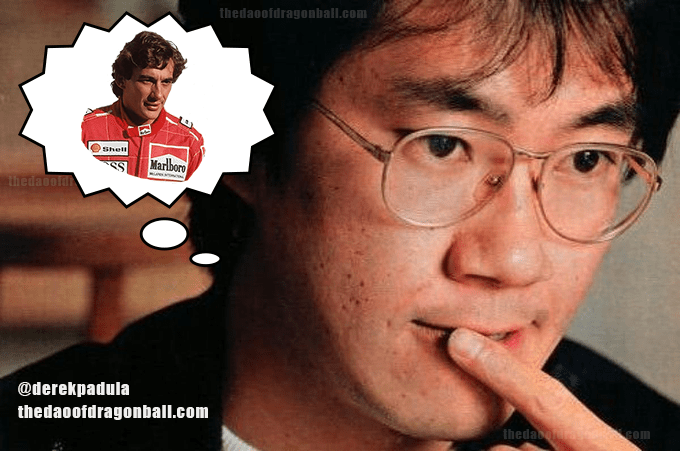
Nothing is known of Toriyama’s feelings about Senna at the time of his death, nor now. But it is clear for everyone to see that in 1990 he was elated to have met Senna when he did. Toriyama was an admirer of Senna’s talents and accomplishments.
In hindsight we can look upon their meeting as a point in time when two of the greatest men from their respective nations and fields of expertise would come together.
Toriyama: The master of manga and most famous manga author in the world.
Senna: The master of racing and most famous F1 driver in the world.
Each dedicated to their craft above all else.
Geniuses from different nations meeting in Germany.
Toriyama’s Battleman manga is an archive of this moment.
It shares Toriyama’s feelings about Senna, this race, this sport, and why it is so important to so many.
Now, with all of this said, would you like to read Toriyama’s manga that was inspired by Ayrton Senna?
English Translation!
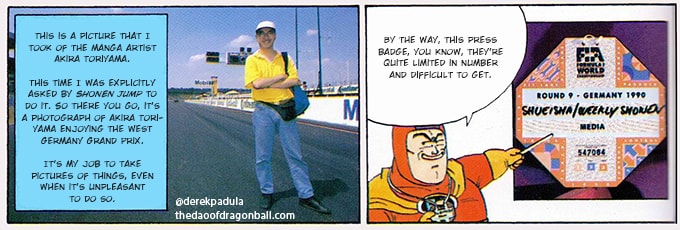
Battleman has never been translated.
Until now!!
I have translated Battleman into English, have cleaned up the pages, and have typeset every word into the original speech bubbles.
After 30 years of waiting, I will publish an English version of Battleman on my site.
And not only will it be translated, but it will also have extensive explanatory footnotes of each real-life person, place, and thing in the manga.
Return this Wednesday to read a world-premiere exclusive at The Dao of Dragon Ball:
Akira Toriyama’s Long-Lost Battleman Formula 1 GP Manga!
Update: Read Akira Toriyama’s Formula 1 Manga here.
Update 2:Read my full explanation of Akira Toriyama’s F1 manga, with a panel-by-panel analysis of the culture and history he put into his work.
' . $comment->comment_content . '
'; } } else { echo 'No comments found.'; }